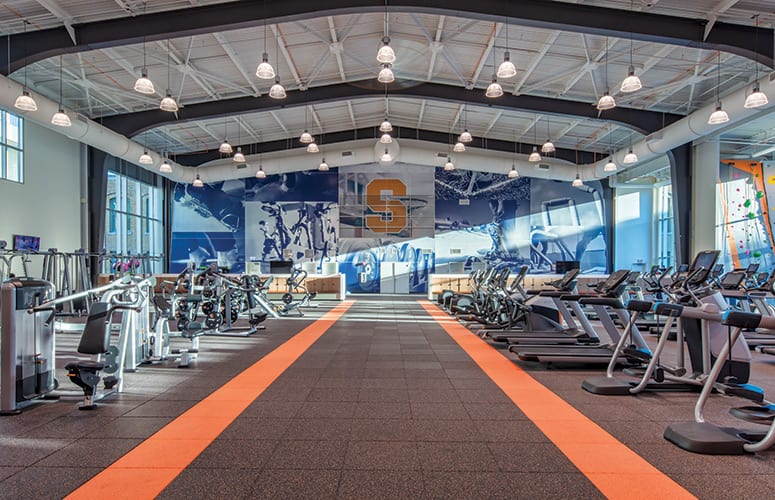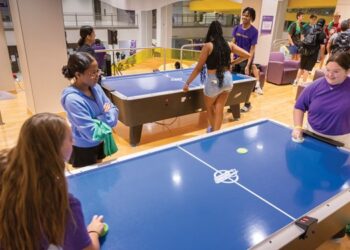In 2019, one of the predominate trending topics in campus recreation was student wellness. When Syracuse University partnered with Populous to design the new Barnes Center at The Arch, they ensured their facility would be ahead of the curve.
“The most prevalent trend is recreation centers are not just about physical recreation and intramural sports,” said Megan Rand, an architect and associate at Populous, and Syracuse alumna. “Health and wellness activities such as pet therapy, peer education, meditation and primary health care are integrated with recreation to create a facility where students find the support they need to thrive and succeed.”
To provide this for their students, the recreation team at Syracuse created a central hub for students that would integrate health and wellness, allowing all the services within the space to connect with each other. “I would describe everything in the space as being focused on wellness,” said Cory Wallack, the interim executive director of student health and wellness at Syracuse.
One unique wellness offering added is the Deborah A. Barnes Pet Therapy Program, housed within the Walters Pet Therapy Room. Due to it already being a popular offering in small events, a lot of thought went into figuring out how to make pet therapy a more permanent program. Now, students are able to destress with two to three hours of pet therapy four to five days a week through local volunteer agencies.
Another unique offering within the Barnes Center at The Arch is the Crowley Family MindSpa, consisting of three small rooms, each designed to promote relaxation. These spaces include light therapy and aromatherapy, as well as guided meditations and biofeedback through Unyte and Muse devices. Outside of the rooms is a lounge area fitted with massage chairs for those waiting or passing time.

“The whole idea of that space is to have a chance to relax and get away from the chaos of the world,” said Wallack. “Immediately, the pet therapy and MindSpa rooms are adjacent to the main quarter that goes into the recreation space. It’s a predominate pathway where there’s foot traffic.”
Creating a pathway and flow throughout the facility was an overarching goal to integrating health and wellness services and creating a hub. “What that means to designers is spaces must communicate a sense of welcoming and belonging, and be flexible to accommodate an ever-increasing range of activities, all while creating an integrated experience and sense of place,” described Rand. “We are moving away from ‘big box spaces’ that don’t relate to each other, focusing on transparency of activities to allow students to discover new interests.”
Matthew Hackett, the director of recreation at Syracuse, elaborated on the benefit of these integrated spaces. “The broader array of options you can provide will bring a larger sector of the campus community inside,” he said. “Whether you’re coming to work out, decide to go to the pharmacy, have a health appointment or pick up some information about one of the health promotion awareness programs, people are really taking advantage of the integrated wellness in the co-location for students.”










